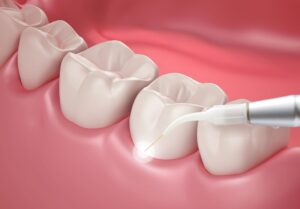Do Root Canals Hurt

Root canals typically do not hurt during the procedure itself. Local anesthesia numbs the affected tooth and gums, ensuring you won’t feel pain. The discomfort associated with root canals usually comes from the tooth before treatment, due to infection or decay.
Once the infected pulp is removed, the pain subsides. Contrary to popular belief, painful root canals are a myth. Prompt treatment is essential to prevent further complications.
Table of Contents
Do Root Canals Really Hurt or Is It a Myth?
Root canal treatments have a reputation for being painful, but with advances in dental techniques and anesthesia, the procedure itself is generally painless.
The discomfort most people associate with root canals often comes from the infection leading to the procedure, not the treatment itself.
Here’s what you can expect in terms of discomfort or pain during and after a root canal:
During the Procedure
- Anesthesia: A local anesthetic is administered to numb the area around the affected tooth, ensuring that you won’t feel any pain during the procedure. You might feel a slight pinch when the needle is injected, but the area will become numb quickly.
- Sensation: While you won’t feel pain during the procedure, you might feel pressure or vibrations from the dental tools.
After the Procedure
- Immediate aftermath: Once the anesthetic wears off, you may experience some tenderness or discomfort in the area for a few days. This is usually due to the inflammation of the tissue surrounding the tooth, rather than the procedure itself.
- Mild pain: Any pain that follows is typically mild and can be managed with over-the-counter pain relievers like ibuprofen or acetaminophen.
- Recovery: Most people can return to their normal activities the next day. You might feel pain after root canal, but it shouldn’t be intense. If it is the case, see your dentist.
Factors That Can Affect Pain Levels
- The severity of the infection: The level of infection and inflammation before the procedure can impact the discomfort experienced afterward.
- Technique and experience: The dentist’s or endodontist’s technique and experience can also influence the comfort level during and after the procedure.
- Individual pain threshold: People have different thresholds for pain and discomfort, so experiences can vary widely.
In short, while the thought of a root canal might be intimidating, the procedure itself is usually not painful, thanks to effective local anesthesia. Any post-procedure discomfort is typically manageable and temporary.
If you’re experiencing anxiety about the procedure, discuss it with your dentist or endodontist beforehand—they can provide additional information and support to help ease your concerns.
How Do You Know You Need a Root Canal?
You might need a root canal if you’re experiencing certain symptoms that suggest the pulp inside your tooth is infected or inflamed.
Here are some signs to watch for:
- Persistent pain: Ongoing pain is one of the most noticeable signs. This can range from a dull ache to severe pain and might be constant or come and go. Pain can also radiate to the face, jaw, or other teeth.
- Sensitivity to hot and cold: If your tooth hurts when you eat or drink hot or cold foods and beverages, and the sensitivity lingers for a while even after you’ve stopped eating or drinking, it might indicate a problem that requires a root canal.
- Tooth discoloration: An infection in the pulp can cause your tooth to become discolored. A tooth might look grayish, brown, or black compared to your other teeth.
- Swollen gums: Swelling around the tooth, which may be tender or painful to touch, can be a sign of an infection that might require a root canal. The swelling might come and go.
- Pain when you eat or touch the tooth: If your tooth is sensitive or painful when you chew or apply pressure to it, this could indicate that the nerves inside the tooth are affected.
- A cracked or chipped cooth: If you’ve cracked or chipped a tooth in an injury or by eating something hard, bacteria can get inside the tooth and lead to infection. This might eventually require a root canal to treat. This is not a craze line.
- Gum Boils, Pimples, or Pus: The presence of a gum boil, pimple, or pus oozing from around the affected tooth is a clear sign of infection. This is also known as a dental abscess.
- Loose Tooth: If one of your teeth starts feeling loose, it might be due to the infection weakening the supporting bone structure.
See a dentist if you’re experiencing any of these symptoms. Ignoring them could lead to the infection spreading, loss of the tooth, or even systemic infections affecting other parts of the body. Read more: How Long Until A Tooth Infection Kills You?
What Happens During a Root Canal Treatment?
A root canal treatment is a dental procedure used to remove infected or damaged pulp from inside a tooth, aiming to save the tooth and alleviate pain.
Here’s a step-by-step overview of what happens during a root canal treatment:
- X-rays: If a root canal is deemed necessary, the dentist or endodontist (a dentist specializing in such treatments) will first take X-rays to assess the extent of the damage and plan the procedure.
- Local anesthesia: To ensure comfort, a local anesthetic is administered to numb the area around the affected tooth. You might feel a slight pinch when the needle is injected, but the area will quickly become numb.
- Dental dam: A small sheet of rubber or plastic, called a dental dam, is placed over the area to isolate the tooth and keep it clean and dry during the procedure.
- Drilling an access hole: The dentist or endodontist will drill an access hole into the tooth to reach the pulp. This is done with special tools designed for precision and minimal discomfort.
- Removing the pulp: The infected or damaged pulp is removed through the access hole. Tiny instruments called files are used to clean out the root canals and shape them, preparing them for filling. This process also involves flushing away debris and bacteria with water or an antimicrobial solution.
- Filling the root canals: Once the canals are cleaned and dried, they are filled with a biocompatible material, usually a rubber-like substance called gutta-percha. This filling helps to prevent bacteria from re-entering the root canals.
- Sealing the Tooth: The access hole created at the beginning of the procedure is sealed with a temporary or permanent filling to prevent contamination of the root canals.
- Restoration: Because a tooth that needs a root canal often has a large filling or extensive damage, a crown may be needed to protect the tooth, prevent it from breaking, and restore it to full function. This may be done in a separate appointment.
Aftercare involves managing any discomfort with over-the-counter or prescribed pain medication and maintaining good oral hygiene practices. It’s normal to feel some tenderness in the area for a few days after the procedure due to natural tissue inflammation, especially if there was pain or infection before the procedure.
While root canal treatments have a reputation for being painful, most people report that the procedure itself is no more painful than getting a filling, thanks to modern techniques and anesthetics. The relief from the pain of the infection is often immediate.
FAQ on Do Root Canals Hurt
How badly does a root canal hurt?
A root canal procedure itself is generally not painful due to the use of local anesthesia, which numbs the tooth and surrounding area. Any discomfort experienced usually comes from the infection before the treatment rather than the treatment itself. Post-procedure discomfort is typically mild and manageable with over-the-counter pain medication.
What’s the most painful part of root canal?
The most painful part of a root canal can be the discomfort felt before the procedure due to the infection within the tooth. Once the procedure starts and the area is numbed, patients should not feel pain.
Do root canals hurt more than fillings?
Root canals do not typically hurt more than fillings because both procedures are performed under local anesthesia to numb the area. The discomfort from root canals usually stems from the infection before the procedure, while fillings might cause mild discomfort due to the preparation of the tooth.
What’s the most painful dental procedure?
The perception of the most painful dental procedure can vary by individual, but procedures involving gum surgery, such as periodontal surgeries or extractions of impacted wisdom teeth, are often considered more uncomfortable due to the involvement of soft tissue and post-procedure recovery.
Fact Checked
Our dedicated team rigorously evaluates every article and guide to ensure the information is factual, up-to-date, and free of bias.
Updated Regularly
We update our articles and reviews regularly to ensure you have access to the latest data in the dental industry.
The content on Dental3DU’s blog is intended for educational purposes only. This information should not be relied upon as professional medical counsel. Be sure to always consult with your dentist about the dangers and benefits of any medication, treatment or procedure.







